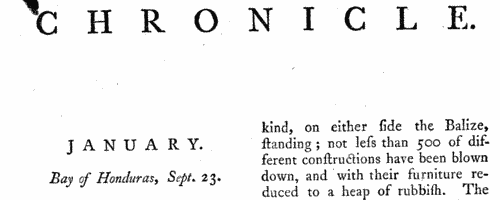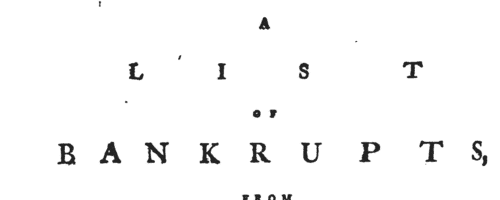Our indexes include entries for the spelling gilbert. In the period you have requested, we have the following 2,121 records (displaying 711 to 720):
Parish Registers of Morden in Surrey: Burials
(1788)
The parish of Morden lay in Wallington hundred of Surrey, and in Surrey archdeaconry of the diocese of Winchester. F. Clayton prepared this transcript of the four earliest surviving registers, which was privately printed for the Parish Register Society as their 37th volume in 1901. | Sample scan, click to enlarge

|
People in the News
(1788)
The Annual Register for 1788 contained a section entitled 'Chronicle', summarizing the year's major events in London, Britain and abroad: and to this was added an appendix containing the texts of interesting dispatches from correspondents. | Sample scan, click to enlarge

|
Bankrupts
(1789)
A list of bankrupts in England and Wales from 1 January to 30 June 1789 giving full name (surname first), address and occupation, and the date of bankruptcy.
| Sample scan, click to enlarge

|
 Masters of apprentices and clerks
(1789) Masters of apprentices and clerks
(1789)
Apprenticeship indentures and clerks' articles were subject to a 6d or 12d per pound stamp duty: the registers of the payments usually give the master's trade, address, and occupation, and the apprentice's name, as well as details of the date and length of the apprenticeship. 2 January to 31 December 1789. IR 1/34 | Sample scan, click to enlarge

|
Parish Registers of Morden in Surrey: Baptisms
(1789)
The parish of Morden lay in Wallington hundred of Surrey, and in Surrey archdeaconry of the diocese of Winchester. F. Clayton prepared this transcript of the four earliest surviving registers, which was privately printed for the Parish Register Society as their 37th volume in 1901. | Sample scan, click to enlarge

|
 Apprentices and clerks
(1790) Apprentices and clerks
(1790)
Apprenticeship indentures and clerks' articles were subject to a 6d or 12d per pound stamp duty: the registers of the payments usually give the master's trade, address, and occupation, and the apprentice's name, as well as details of the date and length of the apprenticeship. 2 January to 31 December 1790. IR 1/34 | Sample scan, click to enlarge

|
 Masters of apprentices and clerks
(1790) Masters of apprentices and clerks
(1790)
Apprenticeship indentures and clerks' articles were subject to a 6d or 12d per pound stamp duty: the registers of the payments usually give the master's trade, address, and occupation, and the apprentice's name, as well as details of the date and length of the apprenticeship. 2 January to 31 December 1790. IR 1/34 | Sample scan, click to enlarge

|
 Apprentices and clerks
(1791) Apprentices and clerks
(1791)
Apprenticeship indentures and clerks' articles were subject to a 6d or 12d per pound stamp duty: the registers of the payments usually give the master's trade, address, and occupation, and the apprentice's name, as well as details of the date and length of the apprenticeship. 5 March to 31 December 1791. IR 1/35 | Sample scan, click to enlarge

|
 Apprentices registered in Devon
(1791) Apprentices registered in Devon
(1791)
Apprenticeship indentures and clerks' articles were subject to a 6d or 12d per pound stamp duty: the registers of the payments usually give the master's trade, address, and occupation, and the apprentice's name, as well as details of the date and length of the apprenticeship. There are central registers for collections of the stamp duty in London, as well as returns from collectors in the provinces. These collectors generally received duty just from their own county, but sometimes from further afield. The indentures themselves can date from a year or two earlier than this return. (The sample entry shown on this scan is taken from a Bristol return. Each entry has two scans, the other being the facing page with the details of the indenture, length of service, and payment of duty.) IR 1/66 | Sample scan, click to enlarge

|
 Apprentices registered in Suffolk
(1791) Apprentices registered in Suffolk
(1791)
Apprenticeship indentures and clerks' articles were subject to a 6d or 12d per pound stamp duty: the registers of the payments usually give the master's trade, address, and occupation, and the apprentice's name, as well as details of the date and length of the apprenticeship. There are central registers for collections of the stamp duty in London, as well as returns from collectors in the provinces. These collectors generally received duty just from their own county, but sometimes from further afield. The indentures themselves can date from a year or two earlier than this return. (The sample entry shown on this scan is taken from a Bristol return. Each entry has two scans, the other being the facing page with the details of the indenture, length of service, and payment of duty.) IR 1/66 | Sample scan, click to enlarge

|
Research your ancestry, family history, genealogy and one-name study by direct access to original records and archives indexed by surname.












